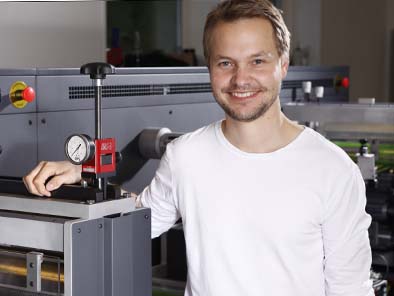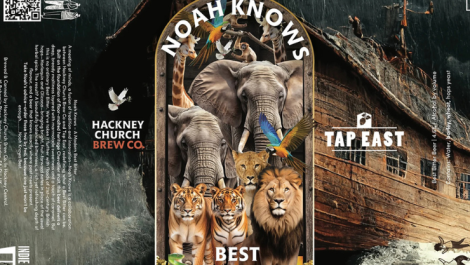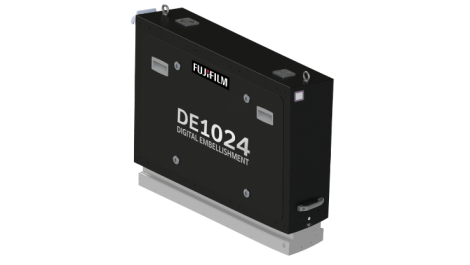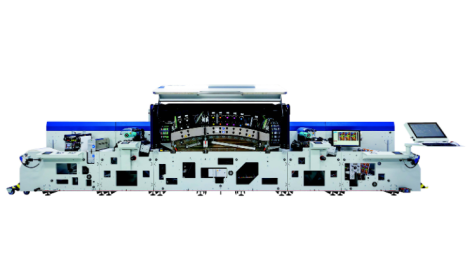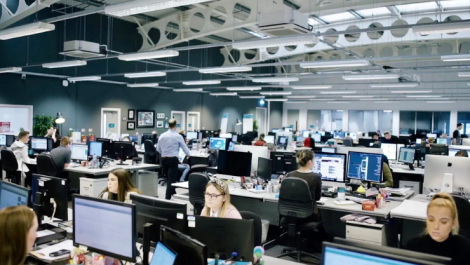The quest to add value to digital print translates into increasingly more sophisticated finishing and converting equipment being developed. Neel Madsen reports.
Finishing and/or converting, depending on your definition, are the processes that turn the printed sheets or reels into labels and packaging. Automation, quick changeovers, flexibility and adding value are the drivers behind the latest kit on the market.
Aiming high
Grafisk Maskinfabrik (GM) has a long history of developing finishing systems for the label industry. The Danish company was established in 1975 and remains in the hands of the same family.
The company has seen demand for fully automated set ups rise and is committed to developing ‘Industry 4.0’ solutions, said CEO Uffe Nielsen, who also mentioned meeting the demands for ultra short run applications as a trend, along with Cloud connectivity and full integration.
For high-end drinks labels, the company has the DC330FB Combination finishing line, which at its heart has the DC330mini compact, with hot foiling, embossing and screen-printing added to create one workflow. ‘This line is ideal for short to medium run high-quality labels, particularly wine labels,’ explained Mr Nielsen.
The finishing line has been designed with a separate unwind on the compact section, so the machine can be used in full mode to produce high-end labels, or in basic mode, so that jobs which only require the flexo station, cold foiling and die-cutting can bypass the other features and run at higher speeds compared to feeding the whole line.
The DC330FB features a rotating foil tower on the hot stamping unit, which can accommodate two foils to run either along or across the web. This allows embossing and foiling to be done in one operation. Mr Nielsen explained, ‘This is quite important for designs where for instance you have both embossing and foiling on one label, but have a section where there is embossing, but no foiling.’
The module has a pressure of 30 tonnes and the servo-drive system ensures equal pressure and impression time at all speeds. A built-in foil saver minimises running costs. It also features ‘slide-out’ plate loading which means plates can be changed while hot.
Automatic setting
AB Graphic continues to manufacture a variety of automation modules for its flagship digital finishing machine, the Digicon Series 3.
‘Since the launch of Series 3 in 2015, we’ve seen a rising trend for high automation modules,’ said sales director Tony Bell. ‘This became very apparent straight after launch, with customers investing in high-end modules and features that saved set up times. Machine downtime is costly, and traditionally each time you changed a job, the machine was stopped whilst the operator set up for the next job.’
Two key modules launched last year were the Fast Track die, a semi-rotary die running at speeds of up to 150 m/min across a wide range of repeats, and the fully automatic Auto set Vectra SGTR glueless turret rewinder.
‘Traditionally we offered a buffer with a semi-automatic turret to produce finished rolls on the end of a Digicon. This was because we didn’t have a turret offering automatic changeover. With the semi-automatic, the operator had to complete the changeover in the time it took the buffer to fill. Launched at Labelexpo Americas, the new Auto automatically sets up in seconds, which allows it to be used for even the shortest of runs,’ explained Mr Bell.
Available both as a standalone turret rewinder and as an integrated module for the Digicon 3, the Auto set promises to save hours of set up time. Mr Bell said, ‘By introducing the Auto set turret rewinder onto the Digicon 3, we faced a new challenge of inspection. To overcome this, our FleyeLink Workflow manager creates a roll map of defects that can be doctored in a final process to eradicate substandard labels. Using a barcode printer for closure labels on the end of the turret, the small rolls with faults can be identified and then run quickly through a small rewinder that highlights where the errors are, ready to be doctored. It’s a very efficient way of getting high quality product through the finishing department to the end user.’
Quick start
Italian converting manufacturer, Prati, which was established in 1973, first introduced the Digifast One converting line at Labelexpo 2015 to meet the needs of digital printing. Its top speed is 80 m/min and job set up takes eight minutes, producing minimal waste in the process, and boasting accurate finishing with a tolerance of max. 0.15 mm, enabled by the FastCut automated knife and counter-knife positioning device.
‘Speed is not everything when it comes to productivity. It is certainly one aspect, but not the most significant one,’ said sales and marketing manager Chiara Prati. ‘Considering the downward trend in job lengths, minimal job changeover times are crucial. In fact this is more important than the pure speed of digital finishing.’
She continued, ‘With Digifast One, operators spend no more than eight minutes between jobs, so productivity rockets by 40% over a typical working week. Week after week, converters accumulate a significant competitive advantage. Furthermore, waste material generated on each job is kept to a strict minimum, not only reducing material costs, but also avoiding the time spent disposing of metres and metres of material for each single job.’
The system is modular and can be built to the customer’s requirements with many options available, including automatic backscoring unit for side-trimming, semi-rotary flexo unit together and cold foiling for standard sheet lamination, spot lamination, super-varnishing and UV lamination. The twin shaft of the semi-automatic turret can handle two rolls simultaneously. This allows operators to set up pre-glued cores on one shaft, ready for the next roll, while the other shaft is winding.
Intelligent automation
Delta ModTech, headquartered in Minneapolis, started in 1978 as a service provider for servo systems and motion control in the machine tool industry. Today it designs and builds flexible platforms for web converting, packaging, finishing and coating.
It has the modular Spectrum finishing system which offers the flexibility to die-cut and coat digitally printed web inline with a digital press or off-line as a standalone finishing system. Each is designed based on the customer’s needs.
Having been part of the new Finishing Experience daily show at Labelexpo Americas 2016, the Spectrum was on show again at Dscoop in Phoenix this March, demonstrating its tight tolerance semi-rotary die-cutting, high-speed output and on the fly changeovers. With the company’s Intelli-Mod control system and touchscreen HMI, operators are able to quickly changeover from job to job.
Amy Elfering, marketing, commented, ‘Dscoop was busy; attendees were impressed with the demonstration and especially like the ease of use and high quality output. The control system features proven print to die registration software that will automatically adjust the die-cuts to print variations. The modular platform allows you to painlessly add capabilities that will set your labels apart from the competition.’
On the can
Developments in converting technologies and changes in packaging formats have opened up new markets for digital packaging printing companies, such as shrink sleeves and stand up pouches. Karlville offers multiple technology platforms for high quality can decoration. It has also worked has worked with HP Indigo to produce the laminating machine for the Pack Ready concept.
Karlville recently introduced two new lines for can sleeving: Low speed of 100 cans per minute (cpm) and High speed (up to 700 cpm). Its shrink sleeve application technology SP600 is a high-speed, linear flow, single head application system that is able to produce up to 700 cpm on a compact footprint.
Bill Hernandez, director of sales for shrink sleeve equipment, explained that the company’s many years of expertise and solid technical team allow them to develop custom-made solutions for each customer’s project. The shrink sleeve equipment is capable of running lower gauge material and using narrower layflats at the high speed, which will enable customers to save on label cost and material waste. The ability to use shorter run length has allowed customer to do market testing with different sized cans and different SKUs.
He said, ‘Karlville’s technology solutions opens up new business opportunities to support cans segment growth. Short runs, seasonal decoration, personalised design, ‘share a name’ campaigns are possible at substantial short lead times, controlled cash flow and reduced inventory.’

